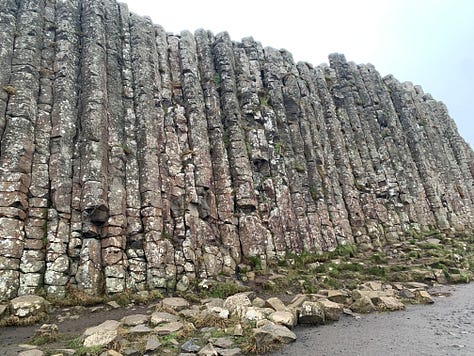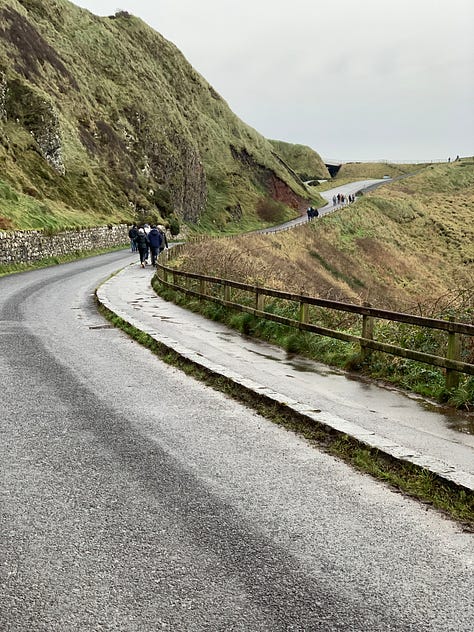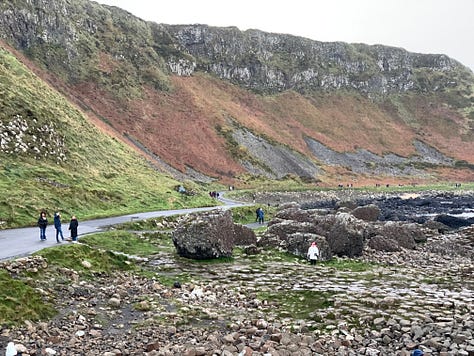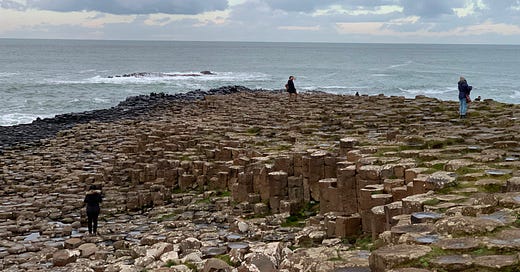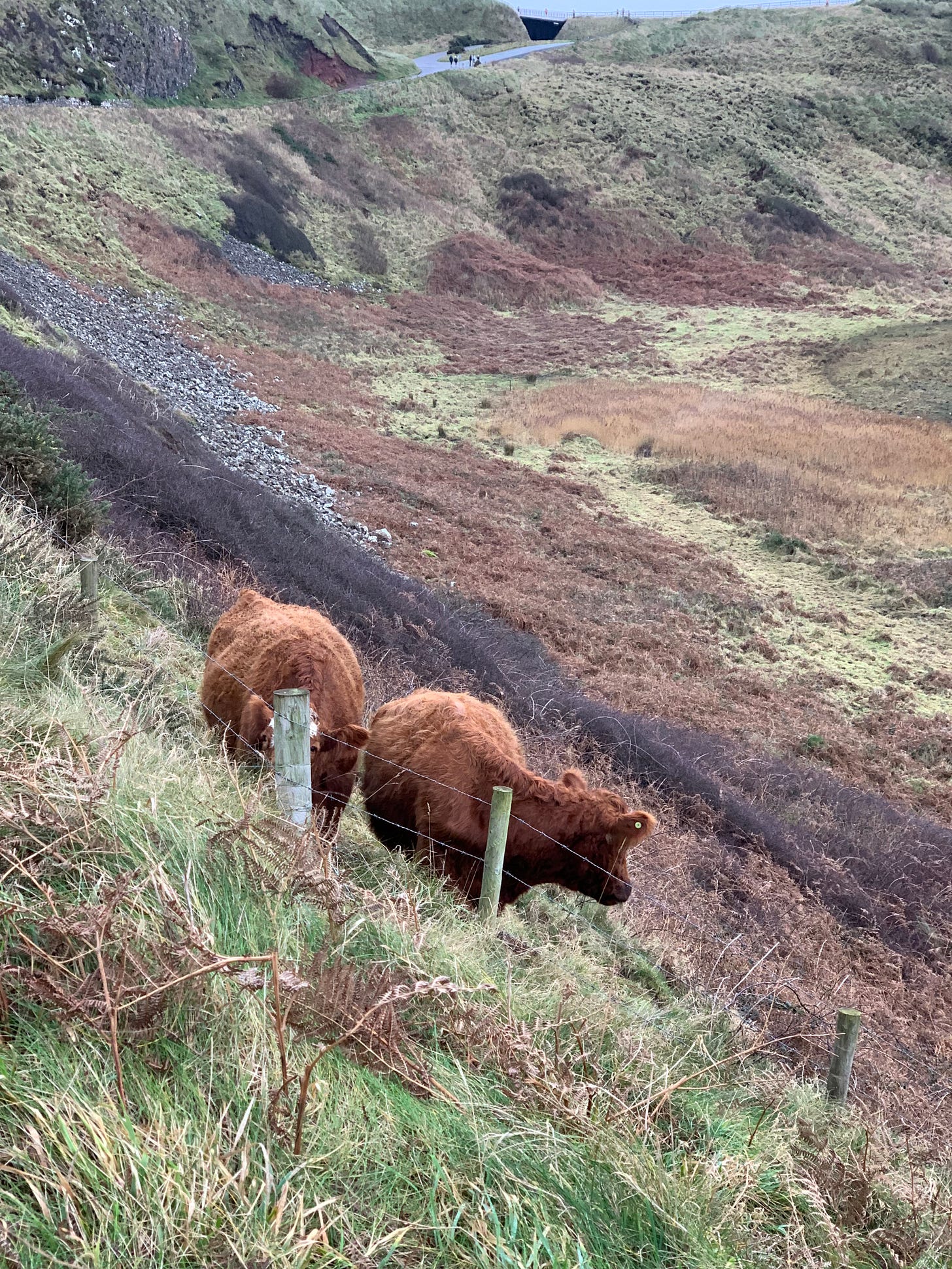Walking in the Footsteps of Giants.
A Wet December St Stephen’s Day Visit to the Giant’s Causeway
It has been over 16 years since I last walked in the footsteps of giants at Northern Ireland’s Giant’s Causeway. Time hasn’t diminished its impact. If anything, the return felt like rekindling a connection with an ancient story—a tale etched into the stones of this dramatic landscape.
As legend tells us, the huge hexagonal stones are the stepping stones of Finn McCool’s causeway. The Irish Giant, Finn, built this natural marvel to cross the Irish Sea and confront his rival, the Scottish Giant Benandonner. Yet the story is more than myth here—it’s a living part of the coastline, whispered in the waves and echoed in the winds that sweep across the Antrim cliffs.
On this St Stephen’s day, the weather felt appropriately Irish. A soft drizzle hung in the air, painting the hills a richer green and saturating the fiery orange of the bracken. The dampness seemed to bring the landscape to life, every rock and blade of grass glistening under the overcast sky.
The walk to the causeway began on the winding coastal path, where cattle grazed on steep, untamed slopes, undisturbed by the weather or the modern world. Below, the road meandered, dotted with visitors wrapped in raincoats and umbrellas. Some hurried along, seeking refuge, while others paused to marvel at the cliffs, the roar of the Atlantic ever-present in the background.
Reaching the Giant’s Causeway itself is always a moment of awe. The basalt columns—formed over 60 million years ago by volcanic activity—rise in geometric perfection, defying logic with their neat, hexagonal symmetry. These stepping stones stretch out toward the horizon, as though Finn McCool himself had only just laid them down and would soon return to finish his work. The rain soaked the stones, creating a mirror-like surface that reflected the gray skies above.
Despite the weather, there’s an undeniable magic to the Causeway in winter. The crowds are thinner, the atmosphere more intimate. You can stand in quiet wonder, listening to the crash of waves and imagining the thunderous footsteps of giants.
Sixteen years ago, the day was brighter, the stones drier and sea calmer. This time, under the overcast and moody December sky, the Causeway felt different—wilder, more raw. The drizzle weaved the legend more tightly into the landscape, blurring the lines between fact and folklore.
As I retraced my steps along the path, I couldn’t help but feel grateful for the rainy weather, it reminded me that some places don’t just endure—they transform. The Giant’s Causeway is one of them. Rain or shine, it remains a place where the natural world and human imagination collide, a testament to both the power of nature and the stories we create to explain it.
The Giant’s Causeway Visitor Centre, operated by the National Trust, is a key attraction that adds depth to the experience of visiting this UNESCO World Heritage Site. The centre showcases interactive exhibits on the natural history, geology, and legends surrounding the site. It also features a gift shop, café, and facilities that make it a convenient stop for visitors. However, it’s worth noting that the visitor centre was closed when we visited on St Stephen’s Day last year, so it’s a good idea to check operating hours in advance if planning a holiday visit.
A short walk away lies the Causeway Hotel, a charming place to stay with views over the dramatic coastline. For whisky enthusiasts, the nearby Old Bushmills Distillery, located just a few miles from the Causeway, offers guided tours and tastings. On my last visit, I indulged in their selection of whiskies, including some rare editions that showcased the depth of Irish distilling traditions. It was a highlight of my trip to this beautiful part of Northern Ireland .
And finally of course, you can’t travel to the Antrim Coast without a visit to the Carrick-a-Rede Rope Bridge. While possibly a better summer adventure, Carrick-a-Rede offers a thrilling walk 100 feet above the Atlantic. Connecting the mainland to Carrick-a-Rede Island. Once used by salmon fishermen, it now provides visitors with stunning coastal views and a glimpse of Scotland on clear days. The mile-long trail to the bridge is equally scenic, featuring dramatic cliffs and vibrant birdlife. A fisherman’s cottage awaits on the island for exploration. A timed ticket system ensures visitor safety and conservation, with tickets available on the day of the visit.
If you’re planning an Irish road trip, make the journey to the Giant’s Causeway and surrounding attractions. Embrace the drizzle, the wind, the wildness. You’ll leave with more than just photographs—you’ll carry a piece of its magic with you.

